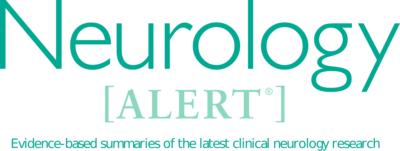
Neurology Alert – October 1, 2023
October 1, 2023
View Issues
-
Comparison of the Efficacy of Rituximab vs. Ocrelizumab in the Treatment of Relapsing Multiple Sclerosis
Rituximab is an anti-CD20 chimeric monoclonal antibody used off-label to treat multiple sclerosis (MS). Ocrelizumab is a humanized monoclonal anti-CD20 monoclonal antibody that is Food and Drug Administration-approved for the treatment of MS. In this observational cohort study, the authors were not able to demonstrate noninferiority of rituximab compared to ocrelizumab because of a significantly lower relapse rate in the ocrelizumab-treated group.
-
Nitrous Oxide-Induced Neuropathy
Nitrous oxide-induced neuropathy presents with a rapidly progressive sensorimotor neuropathy that may mimic Guillain-Barré syndrome. The pattern of clinical weakness and progression, as well as electrophysiological features, can help to rapidly distinguish the two disorders.
-
Radiosurgery vs. Watch-and-Wait Approach for Newly Diagnosed Vestibular Schwannoma
Vestibular schwannoma is the most common tumor of the cerebellopontine angle. There is controversy regarding the management of these benign tumors with up-front radiosurgery vs. observation, especially for those that are small- to medium-sized with minimal symptoms. Recent evidence suggests that up-front radiosurgery may reduce tumor volume at four-year follow-up.
-
Tenecteplase vs. Alteplase for Treatment of Acute Ischemic Stroke: It Is Time to Make the Change
Since 1996, when the U.S. Food and Drug Administration approved the use of intravenous alteplase for the treatment of acute ischemic stroke, there has been a steady increase in the adoption of both intravenous thrombolysis as well as endovascular thrombolysis and mechanical thrombectomy for the treatment of patients with acute ischemic stroke and large vessel occlusion. There now is extensive experience with the use of tenecteplase for the treatment of acute ischemic stroke. It has been shown to be equally efficacious, with a similar risk profile as alteplase.
-
Blood Pressure Management After Endovascular Thrombectomy: What Is the Best Number?
Approximately 50% of patients who undergo endovascular therapy for ischemic stroke still have a severe impairment or will die within 90 days. Therefore, additional interventions are being investigated to improve overall outcome. Current guidelines from the American Heart Association suggest maintaining systolic blood pressure below 180 mmHg for patients who were treated both with intravenous thrombolysis and endovascular thrombectomy. A number of centers around the world have tried different systolic blood pressure thresholds ranging from 120 mmHg to 160 mmHg. Many of these studies have been single-center or small non-randomized studies and have not been designed to get a definitive answer.
